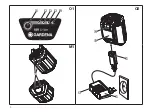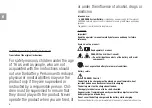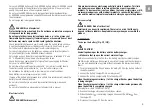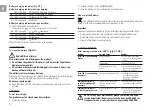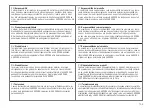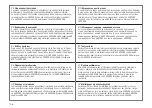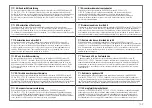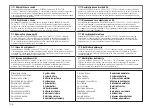
9
EN
Only use GARDENA batteries for the GARDENA battery product. GARDENA cannot
accept any liability for the batteries of other manufacturers. If they are of minor
quality, they could cause a fire or explosion hazard!
Do not use the GARDENA charger to charge external rechargeable batteries,
as GARDENA cannot guarantee compatibility and could therefore present a risk of
fire or explosion.
Do not charge non-rechargeable batteries.
DANGER! Risk of explosion!
Protect batteries from heat and fire. Do not leave on radiators or expose to
strong sunshine for long periods.
Do not operate them in explosive atmospheres, e. g. in the presence of
flammable liquids (vapours), flammable gases or accumulations of dust.
Batteries may create sparks which could ignite the mixtures.
Check your battery before each use. Visually check the battery before each use.
A non-functioning battery must be disposed of correctly. Do not send by post.
For further details, please contact your local disposal companies.
For risks of injury do not use the battery as a power source for other products.
Only use the battery for the GARDENA product intended.
Only charge and use the battery in ambient temperatures of between 0 °C and
40 °C. Allow battery to cool down after long periods of use.
Check the charging cable regularly for signs of damage or ageing (brittleness).
Only use it in perfect condition.
Do not stow or transport the battery above 45 °C or in direct sunlight. Ideally,
the battery should be stored below 25 °C so that self-discharge is low.
Do not expose the battery to rain, water (immersion) or wet conditions.
Keep battery in order (clean) especially air vents.
If usage of the battery is not planned for a certain time (winter period) reload the
battery to avoid a deep discharge.
Do not store the battery in a product to prevent self-discharge, misuse and
accidents.
Do not store the battery in places where static electricity is present.
Electrical safety
DANGER! Cardiac arrest!
This product makes an electromagnetic field while it operates. This field
may under some conditions interfere with active or passive medical
implants. To decrease the risk of conditions that can possibly injure or kill,
we recommend persons with medical implants to speak with their physi-
cian and the medical implant manufacturer before you operate the product.
Personal safety
DANGER! Risk of suffocation!
Small parts can be easily swallowed. There is also a risk that the poly-
bag can suffocate toddlers. Keep toddlers away when you assemble the
product.
2. OPERATION
To charge the battery [ Fig. O1 / O2 ]:
CAUTION!
Overvoltage damages the battery and the battery charger.
v
Make sure that you use the correct mains voltage.
Before you use the battery the first time, the battery must be completely charged.
The lithium-ion battery can be charged in any state of charge and the charging pro-
cess can be disconnected at any time without to damage the battery (no memory
effect).
1. Push the locking button
>
and remove the battery
Y
from the battery holder of
the battery product.
2. Connect the battery charger
X
into a mains socket.
3. Connect the battery charger cable
V
to the battery
Y
.
When the charging control lamp
å
at the charger flashes green the battery
is being charged.
When the charging control lamp
å
at the charger illuminates permanently
green the battery is completely charged
(Charging time, see 6. TECHNICAL DATA).
4. Examine the charge status regularly while you charge.
5. When the battery
Y
is completely charged, disconnect the battery
Y
from
the charger
X
.
6. Disconnect the charger
X
from the mains.
Summary of Contents for 9865
Page 2: ...O1 y O2 M1 3 å V X Y ...


